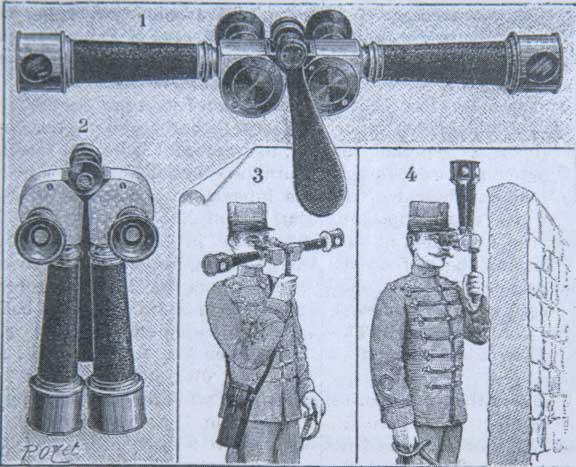Magnification: 10x
Aperture (objective diameter): 25 mm
Field of view: 3.7°
Visible field of view (eyepiece FOV): 37°
The closest focusing distance: 7.5 m
Height: 25 cm
Weight: 821 g
Production date: 1916.
Relief scopes Carl Zeiss Jena Teleplast 10x
In 1893 Carl Zeiss received a patent No.77086, which contained the prism binoculars’ and the relief scopes’ design (the Relief Fernrohr Periscope) based on the modified Porro II prism system. The production of such devices with 6, 8, and 10x magnification started in parallel with the binoculars in 1893/94.
Such relief telescope’s increased stereo base (the distance between the lenses) made it possible to observe distant objects in a more voluminous (plastic) way. In addition, military people got interested in this device, as it allowed inspecting the area from behind a shelter (see photo).

Later, this design became fundamental for creating large trench binoculars and optical range finders.
It is difficult to determine an exact age of such devices; the serial numbering was not continuous (through) until 1907 and it was based on relief scopes’ design changes and on other features. Such devices were less popular than prism binoculars, however, they were appreciated by military people during World War I and they were widely used in the German army.
The devices with 6x magnification were very rare, the 8x- and especially 10x-magnification models were much more widespread. The latter got the Teleplast name, its lenses diameter equaled to 25 mm, and they were protected from damages by swivel sleeves (see photo).
From the constructive point of view, this device is executed in the form of two optical tubes, connected by a cast hinge (it was a frame hinge with a clamping screw up to 1907), with a corrugated clamping washer (starting from 1911) for fixing the tubes’ position, adjusting the interpupillary distance and fixing the wooden handle. Besides, the latter has two fixed positions for the convenience of observations. The device has “lugs” for a neck strap. The upper hinge disk is of the 3rd (later type) and has an interpupillary distances scale (see Hans T. Seeger. Zeiss-Feldstecher, Handfernglaser von 1894-1919, Modelle-Merkmale-Mythos, p.177).
The relief scopes are equipped with the so-called "1/3" design eyepieces (starting from 1904, see Hans T.Seeger. Zeiss-Feldstecher, Handfernglaser von 1894-1919, Modelle-Merkmale-Mythos, p.177) having base diameter equal to 24.5 mm. The eyepieces have a diopter scale, transverse knurling and the specific-shape eyecups.
There are inscriptions "Carl Zeiss Jena" on the left prism cover. There is also an inscription "Teleplast 561875 10x" on the right prism cover. The inscription is made with the help of white paint and is printed in block letters against the background of Carl Zeiss Tessar photo lens schematic image (the earlier models had an inscription in italics until 1904).
The device’s serial number is "561875", it was produced in 1916.
Similar military relief scopes with an angular grid are available by the following link: http://binocollection.com/catalog/binoculars-teleplast-10x-military.html
It is difficult to determine an exact age of such devices; the serial numbering was not continuous (through) until 1907 and it was based on relief scopes’ design changes and on other features. Such devices were less popular than prism binoculars, however, they were appreciated by military people during World War I and they were widely used in the German army.
The devices with 6x magnification were very rare, the 8x- and especially 10x-magnification models were much more widespread. The latter got the Teleplast name, its lenses diameter equaled to 25 mm, and they were protected from damages by swivel sleeves (see photo).
From the constructive point of view, this device is executed in the form of two optical tubes, connected by a cast hinge (it was a frame hinge with a clamping screw up to 1907), with a corrugated clamping washer (starting from 1911) for fixing the tubes’ position, adjusting the interpupillary distance and fixing the wooden handle. Besides, the latter has two fixed positions for the convenience of observations. The device has “lugs” for a neck strap. The upper hinge disk is of the 3rd (later type) and has an interpupillary distances scale (see Hans T. Seeger. Zeiss-Feldstecher, Handfernglaser von 1894-1919, Modelle-Merkmale-Mythos, p.177).
The relief scopes are equipped with the so-called "1/3" design eyepieces (starting from 1904, see Hans T.Seeger. Zeiss-Feldstecher, Handfernglaser von 1894-1919, Modelle-Merkmale-Mythos, p.177) having base diameter equal to 24.5 mm. The eyepieces have a diopter scale, transverse knurling and the specific-shape eyecups.
There are inscriptions "Carl Zeiss Jena" on the left prism cover. There is also an inscription "Teleplast 561875 10x" on the right prism cover. The inscription is made with the help of white paint and is printed in block letters against the background of Carl Zeiss Tessar photo lens schematic image (the earlier models had an inscription in italics until 1904).
The device’s serial number is "561875", it was produced in 1916.
Similar military relief scopes with an angular grid are available by the following link: http://binocollection.com/catalog/binoculars-teleplast-10x-military.html
